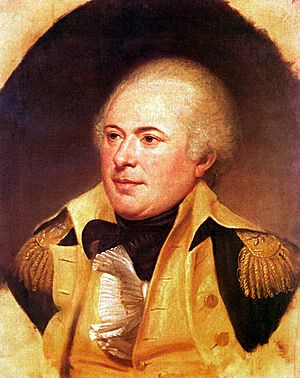Battle of Kenapacomaqua facts for kids
Quick facts for kids Battle of Kenapacomaqua |
|||||||
|---|---|---|---|---|---|---|---|
| Part of Northwest Indian War | |||||||
|
|||||||
| Belligerents | |||||||
| Wea Tribe | |||||||
| Commanders and leaders | |||||||
| Unknown | James Wilkinson | ||||||
| Strength | |||||||
| 8 warriors | 525 militia | ||||||
| Casualties and losses | |||||||
| 9 killed 34 captured |
2 killed 1 wounded |
||||||
The Battle of Kenapacomaqua, also known as the Battle of Old Town, was a quick attack in 1791. It involved United States forces led by Lieutenant Colonel James Wilkinson. They raided the Miami (or Wea) town of Kenapacomaqua. This town was located on the Eel River in what is now Indiana. The battle took place about six miles from today's Logansport, Indiana.
Contents
What Led to the Battle?
Planning the Attack
In 1791, Governor Arthur St. Clair of the Northwest Territory was getting an army ready. Their goal was to attack a Native American town called Kekionga. This was in response to a previous defeat in 1790. St. Clair also planned to send a smaller group to distract the Native American fighters.
However, the main army was delayed. So, St. Clair decided to send Wilkinson's raid first. Lieutenant Colonel Wilkinson had already fought in a successful campaign earlier that year. This was called the Blackberry Campaign. During that time, mounted soldiers from Kentucky raided Native American villages. Many people wanted another raid before the summer ended.
Wilkinson's March
Wilkinson's force included 523 Kentucky militia (citizen soldiers). They left Fort Washington on August 1, 1791. They traveled about 70 miles in just two and a half days. They arrived at Kenapacomaqua on August 7, 1791.
The Battle of Kenapacomaqua
The Surprise Attack
Wilkinson immediately crossed the Eel River and attacked the village. What Wilkinson didn't know was that the village was not well defended. Many Native American leaders were away. They were at a big meeting called by Alexander McKee. Other leaders were traveling to Quebec to meet with Guy Carleton.
Also, the people remaining in the village were very sick. They were suffering from a bad flu-like illness. One British observer said that two or three people were dying each day.
Who Was There?
Only eight warriors were left in the village. Sixty warriors were patrolling the nearby Wabash River. Others were in Vincennes buying supplies or gathering food.
The American forces captured 34 Miami people. Most of these were women and children. One of the captives was a daughter of the famous Miami war chief, Little Turtle. The Americans also found and freed one of their own captives in Kenapacomaqua.
Casualties and Damage
During the fight, two Kentuckians were killed. Another was wounded. Nine Miami people died in the battle. Wilkinson himself reported that six of the dead were warriors. Sadly, two women and one child were also killed.
Wilkinson's troops then cut down the corn crops. They also burned the village houses. The militia camped for the night. However, they decided not to go any further. They were worried about being attacked in return. Wilkinson then took the same route back to Kentucky. On the way, he stopped at Ouiatenon to destroy newly planted crops there.
What Happened Next?
Reactions to the Raid
The Western Confederacy (a group of Native American nations) was very angry about the attack. They immediately called for war. Within weeks, news arrived that the United States was starting a larger advance. This main army was moving north from Fort Washington. Observers at Fort Detroit saw many Native Americans heading off to fight.
Wilkinson made his report sound more impressive than it was. He claimed to have destroyed "the chief town" of the Wea. But his success was mainly because Kenapacomaqua was lightly defended. Still, Governor St. Clair and President George Washington were pleased with Wilkinson's raid. Secretary of War Henry Knox saw it as a success. He believed it would help bring peace. As a reward, Wilkinson was given command of a regiment in the main campaign.
A Missed Chance for Peace
Ironically, Guy Carleton had urged peace at his meeting in Quebec that same August. The Native American council left with peace terms for the United States. But when the council reached Fort Detroit, they heard about Wilkinson's raid. They also learned about St. Clair's main army advancing.
The entire council immediately left to defend Kekionga. This led to St. Clair's Defeat on November 4, 1791. This was one of the worst defeats in U.S. Army history. The Northwest Indian War continued for another four years after this battle.


